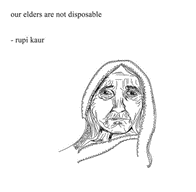Should Insta-poetry be considered Literature?
- Jasmine Chan
- Jan 9, 2021
- 4 min read

In December, Rupi Kaur’s new publication “Home Body” debuted at #1 on New York Times paperback best sellers list, on The Sunday Times and on The Toronto Star. Her success has proven the rise of a new wave in the Literary World — Insta-poetry. With the new form of poetry reaching mainstream success through the assistance of social media, here comes the million-dollar question: Should these rising stars be considered as Literature?
Insta-poetry is defined as an adaptation of poetry into an Internet subgenre emerged because of social media. What gave rise to its popularity, you ask? Perhaps it is because of relatability to the modern audience. Instead of putting people off by convoluted language and intricate metaphors like how traditional poetry tends to, Instapoetry uses simple, every day language that allows easily extractable and straightforward messages, catering to the modern practises of efficiency while emphasizing on authenticity within the chaotic reality. As a plus, they comment on social issues highly relevant to modern society, that appears intriguing to modern readers, such as sexual assault, racism and self-love. In addition, Instagram provides an accessible, interactive platform that allows people to read, comment, like and share information quickly and easily. These functions help spread their works like wildfire, effectively reaching millions of people around the globe, which also contributes to its fast-growing popularity and acceptance among the millennials.
Since its breakthrough into the publication houses and made way onto shelves in bookstores, they have sparked debate on the Internet and within the literary realm. Literary critics heavily criticised Insta-poetry for their lazy writing. In the poetry journal PN Review, poet Rebecca Watts argues that poetry is “redefined as a ‘short-form communication’” that promotes ‘consumer-driven content and “instant gratification”’. With the new Instaworthy aesthetic being a hot drink and a page from milk and honey by Kaur, it is not hard to see where Watts is coming from.
As much as they tend to use metaphorical language with heavy imagery, critics argue that it may be more accurate to classify them as an aesthetic rather than Literature, assisting Instapoets in promoting their brands through social media. Taking home body by Rupi Kaur and the princess saves herself in this one by Amanda Lovelace as an example, what we normally label as statements or even Tumblr/Pinterest quotes are suddenly praised as revolutionary “poetry” just because they are written by these Instapoets. Soraya Roberts argues in the Baffler, “It is not art, it is a good to be sold,” accompanied by refusals from Instapoets themselves, as Robert Macias bluntly states, “I would never consider these poems. I am not a poet”.
To test whether Instapoetry requires genuine talent or is purely based on pretentious writings, creator Andrew Lloyd started a poetry account (@ravenstarespoetry) on Instagram and recorded his 4-week progress on Vice UK. Even though he deliberately made his products as “the kind of drivel that would get you kicked out of Year Five for not trying hard enough”, he “woke up everyday to a fresh batch of likes, comments and followers”, even to receiving intense DMs from readers who connected to his “poems” on a genuine level. @Atticuspoetry, an Insta-poet with 1.2 million followers and a best-selling collection of his own, even complimented them as “amazing work x”. Lloyd then concluded, “It's true a lot of people are masquerading as talented – it turns out this stuff is easy to fake – but that doesn't mean the reaction of the readers isn't real and valid.”
Poetry experts, on the other hand, claim that these Instapoets have given birth to a new, modern form of poetry, which, characterized by pithy lowercase sentences, frequent line breaks, and complimentary doodles, have revolutionized modern readers’ perceptions on poetry. Judith Palmer, director of the Poetry Society, explains that “(Instapoetry) is not really about complex language, it is more about easily translatable universal emotions." In support, Dr Eleanor Spencer-Regan, digital director of the Institute of Poetry and Poetics at Durham University points out that Instapoets have succeeded at increasing diversity in a literary form that is traditionally perceived as one dominated by the “stale, pale male”. According to Palmer, these Instapoets fights elitism and the conventional, entrapping criterion of poetry that limits voices and people of creation: “What we’re seeing is contemporary life reflected and that is the big appeal. People have for too long had this idea that poetry is a small world, and that poetry is one thing. This is an unnecessary narrowing.”
But of course, to question a piece’s classification reminds us of the evergreen challenge of defining Literature – there is just no black-and-white distinction. As the highly acclaimed AE Housman admitted, “I could no more define poetry than a terrier could define a rat.” In face of criticism, Kaur expresses the blurred line between traditional and modern poetry: “We have a form of art that is highly, highly traditional – meaning poetry – and then you have this other thing which is new and quite non-traditional, which is, of course, social media. And so the gatekeepers of these two things are kind of confused at this moment.”
It is undeniable that Instapoetry is a way to bring people of different backgrounds, culture and age together and inspire them to indulge in creative outlets of their own. While you may not necessarily relate to or agree with this emerging form of art, their influence on modern society must not be ignored. If we were to define poetry as literature arranged for its meaning, sound and rhythm, most Instapoetry will be ridiculed as a form of poetry. If we were to define poetry as a form that evokes a concentrated imaginative awareness of experience or a specific emotional response, then Instapoetry truly deserves this title, seeing how well it resonates with modern readers. Ultimately, it is up to you to decide.
Source:








Comments